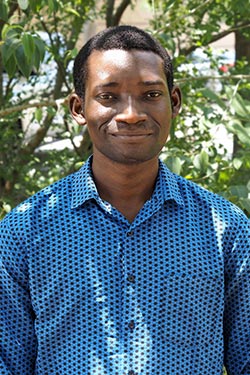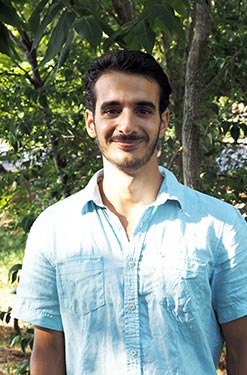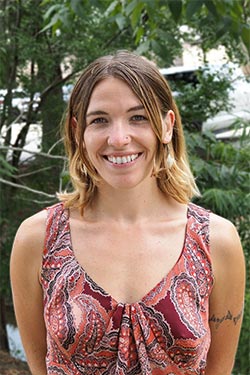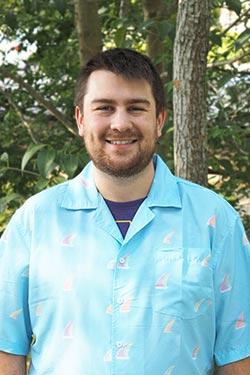First Van Lopik Scholarship Recipients Awarded
Four Louisiana State University (LSU) graduate students are the inaugural recipients of the Dr. Jack and Annagreta Hojhdal Van Lopik Superior Graduate Student Research Scholarship. They are Ebenezer Etsiwah, Wissam Jawad, Mischa Schultz and Daniel Sinopoli.
Jack Van Lopik, the first and longest serving executive director of the Louisiana Sea Grant College Program at LSU, and his wife Annagreta Hojhdal Van Lopik, established the scholarship to assist graduate students pursuing advanced degrees in disciplines related to the mission and focus areas of the Louisiana Sea Grant College Program. The intent is to support the Sea Grant mission of furthering the wise and sustainable use of ocean and coastal resources by increasing the number of researchers and the body of knowledge in related fields including but not limited to biology, ecology, geology, fisheries, environmental science, coastal resiliency and design, natural resources economics, environmental education and disaster preparedness and extension.
Applicants must be full-time graduate students at LSU in good academic standing. Scholarship recipients are awarded $10,000 for one year to cover stipend, conference travel, field travel, field experiences and other expenses.
 Etsiwah is pursuing a master of science degree in civil engineering in the Department of Civil and Environmental Engineering. He earned his bachelor of science degree in chemical engineering from Kwame Nkrumah University of Science and Technology in Kumasi, Ghana.
Etsiwah is pursuing a master of science degree in civil engineering in the Department of Civil and Environmental Engineering. He earned his bachelor of science degree in chemical engineering from Kwame Nkrumah University of Science and Technology in Kumasi, Ghana.
His research project is titled A Novel Disinfection Technology for Onsite Wastewater Treatment using UV-LEDs. Soil conditions of Louisiana, particularly Tangipahoa Parish, make the suitability of onsite wastewater treatment systems – such as septic systems – a challenge. Sewage runoff through ditches and aerated treatment units during intense rainfall has a cumulative impact on nearby water bodies. Recent advances in the use of germicidal ultraviolet light-emitting diodes (LEDs) with wastewater treatment look to be a promising solution. As part of the project, a solar-powered disinfection reactor using LEDs and low doses of chlorine will be developed and tested for its effectiveness with aerated treatment units in the parish.
 Jawad is a doctoral student in the Department of Biology. He earned a bachelor of arts degree in zoology from Michigan State University.
Jawad is a doctoral student in the Department of Biology. He earned a bachelor of arts degree in zoology from Michigan State University.
His research project is titled Understanding the Impact of Heat Waves on the Marsh Periwinkle (Littoraria irrorata) in Louisiana and Across the Species Range. Heat waves can have severe negative impacts on natural communities by causing mass mortalities. In sub-tropical regions such as coastal Louisiana, heat waves can be particularly threatening because many coastal species are already living at their upper temperature limits. Species like the common marsh periwinkle can avoid high temperatures by seeking cooler microhabitats which can increase their exposure to other threats, like predators. The project will investigate how heat waves can impact marsh periwinkles in the wild by altering their vulnerability to blue crabs. As a key species that influences the structure and diversity of salt marsh ecosystems, understanding how heat waves impacts marsh periwinkles could be vital for predicting the future health of salt marshes.

Schultz is a doctoral student in the Department of Oceanography and Coastal Sciences. She earned her master of science degree in natural resources from the University of Missouri, and a bachelor of science degree in natural resources from the University of Georgia.
Her dissertation is titled Greater Amberjack Life History in the Gulf of Mexico. Declines in a number of reef fish species in the Gulf of Mexico have led to regulatory actions such as decreased bag limits and seasonal closures. Greater amberjack is a reef fish important to both commercial and recreational fisheries, yet, like many other reef fish, greater amberjack has been classified as overfished and undergoing overfishing. Despite the recreational importance of the species, there is a lack of scientific studies on greater amberjack in the Gulf of Mexico. With the aim of better understanding greater amberjack life history, Mischa’s research will focus on describing the feeding habits and diet variability of greater amberjack and will characterize the reproductive biology of the species.

Sinopoli is a doctoral student in the Department of Biological Sciences. He earned his master of science degree in fish and wildlife biology management from the State University of New York, College of Environmental Science and Forestry, and his bachelor of science degree in aquatics and fisheries science from the same institution.
His research project is titled Resurrecting the Ancient: New Analyses Reveal Unrecognized Diversity in a Widespread Ancient-lineage Fish. Spotted gar is a widespread species with the core of its range comprising the Mississippi River Basin, the Gulf Coast drainages from northeastern Mexico to the Apalachicola River in Florida and the Rio Grande River as far upstream as the Trans-Pecos region of Texas. There is also a disjunct and rarely observed northern population of spotted gar in southern Michigan and parts of the Great Lakes. In the late 19th century, taxonomists often described similar or identical animals nearly simultaneously, without instantaneous access to the work of their peers, resulting in redundant descriptions. Ultimately, many of these species’ names were invalidated or “sunk,” synonymized under a single name. Between 1858 and 1870, five gar species were described that would ultimately become the single spotted gar we know today. The downside to lumping species prior to genetic analyses is that it can invalidate a potentially valid species name by listing it as a synonym. This project will use molecular and geometric morphometric techniques to re-examine the five synonyms of spotted gar described across its distribution to determine if any synonyms are valid species and should be split from true spotted gar.
For more information on the scholarship, visit www.laseagrant.org/opportunities/student/van-lopik-scholarship.
